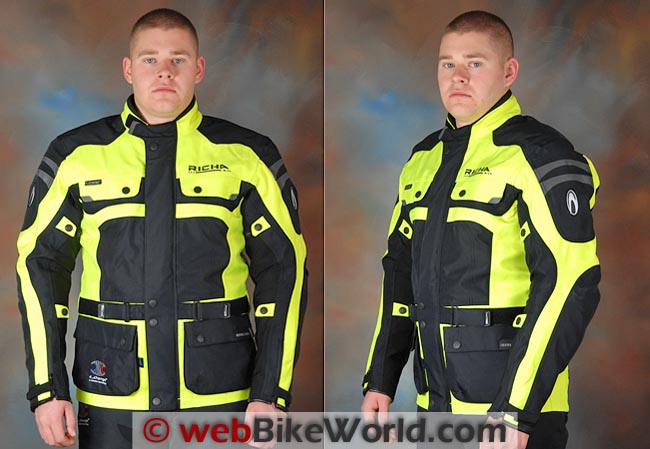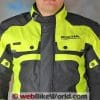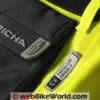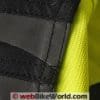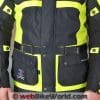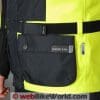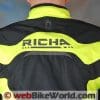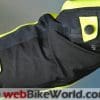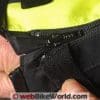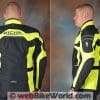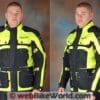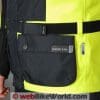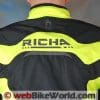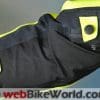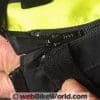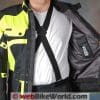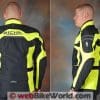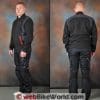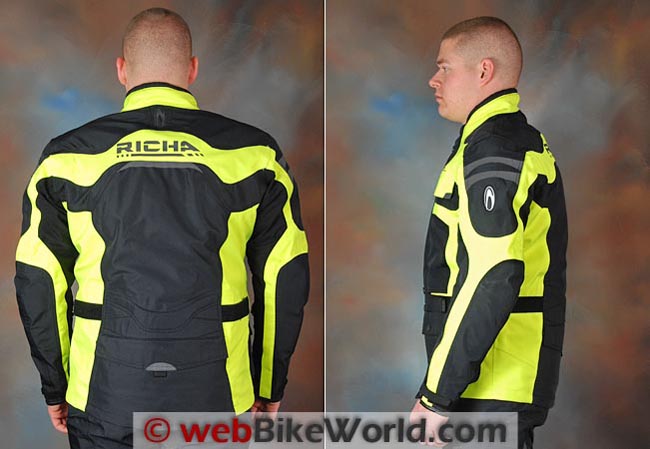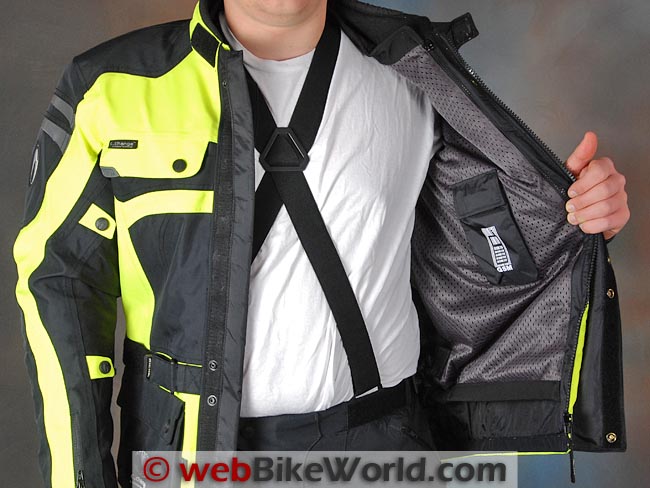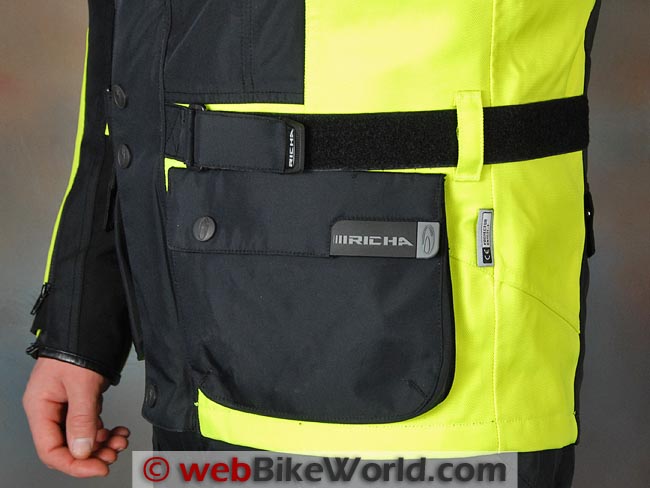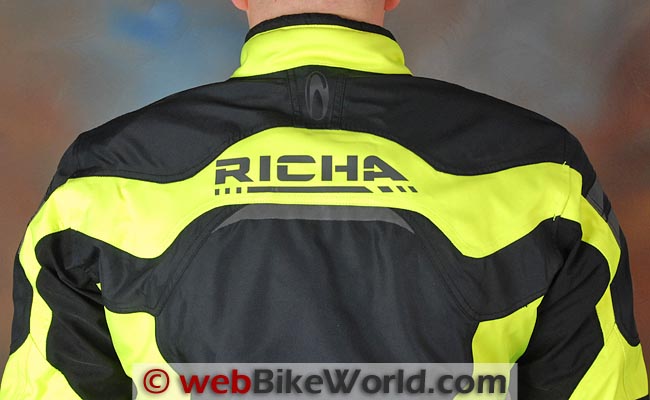Summary
Richa is popular brand of motorcycle clothing in Europe and Richa clothing is now available in the U.S.A., imported and distributed by the Vega Helmet Corporation
The Richa Spirit C-Change jacket and pants are the company’s flagship outfit and the first of the Richa products delivered to the U.S.
The jacket and pants have excellent quality construction and include many of the highest-tech features to be found on motorcycle clothing today.
See Part II: Richa Spirit Pants Review
Also: Richa Arctic Gloves Review
Background
After talking to many different clothing and helmet manufacturers, motorcycle product distributors and retailers of all stripes, I’ve come to appreciate just how difficult it really is to import, distribute, support and sell a product in the U.S.A.
What’s so hard about selling stuff in the U.S., you might ask? All you have to do is bring over a few jackets and put ’em on the rack and you’ll be raking in the cash, right? Wrong…
It’s way too complicated to discuss here, but let’s just say that introducing a new product line is a hugely expensive and incredibly complex logistical undertaking.
It involves everything from import duties to warehousing to customer relations and after-sales support. It also takes a lot of money to get the works up and running and any return on the investment could be years away.
And then there’s the marketing aspect — something that is particularly difficult in the U.S.A., where the distant and disparate consumer market segments present another major challenge as you attempt to introduce and unfamiliar brand to potential customers.
So it’s no wonder we still don’t have Caberg or Lazer helmets for sale here, much as those companies would like to sell you one. And remember Shark Helmets? Yet another case study in the difficulties of entering and sustaining the American market.
That’s why Vega Helmet, the importer and distributor for Richa in the U.S.A., gets a “gold oak leaf cluster with bronze filigree” (to paraphrase the late, great Jean Shepherd) for going through who-knows how many headaches to deliver the Richa goods to American motorcyclists.
Introduction
Richa may seem like a new name to American motorcyclists but, in fact, the company is a very old brand. In fact, they are the very definition of the word “established”, having been in business for over 150 years. That’s “established” with a capital “E”!
Richa NV, headquartered in Belgium, is the world’s “second largest glove manufacturer”, according to the company. Richa got its start (if you can call 125 years a start!) by making gloves, but they’re now best known to motorcyclists around the world for an extensive line of motorcycle clothing and gear that includes everything from boots to tank bags to rain suits to helmets and, yes, gloves.
Richa clothing is very popular with European motorcyclists and I’m sure Vega hopes that the brand will become as popular with American riders too.
Organization of This Review
I’m going to take a different approach with this review and work it “backwards”. First we’ll go deep inside the Spirit jacket and discuss the interesting technologies that Richa has incorporated into the gear.
Then I’ll discuss the special liner that is included in the jacket. Then we’ll work our way outwards, with the CE level protection and abrasion-resistant textiles.
After that, we’ll cover some of the details, then finally the “on the road” impressions and finally, a wrap-up and conclusion. Part II of this review describes the matching Richa Spirit pants (review).
Richa Spirit Technologies: C-Change, NanoSphere, Reflex, Dynatec, Bluesign
The Richa Spirit jacket and matching pants occupy the top spot of the huge Richa product line for 2012. As such, the outfit incorporates some of the highest-tech features currently found in motorcycle gear.
My guess is that both Richa and Vega Helmet decided that if you’re going to launch a new product in a market like the U.S.A., you might as well go with the gold. The strategy: introduce the top-of-the-line gear first and perhaps the high-tech impression of the brand will be sustained as the rest of the product line trickles over.
The Spirit outfit is not inexpensive, so let’s get that out of the way right up front. It’s comparable to similar offerings from Rev’it, Rukka, BMW and others.
I find it interesting and somewhat puzzling that we receive many emails from webBikeWorld readers who want all the bells-and-whistles, including a full waterproof outer shell; CE level protection; class-leading construction, stitching and abrasion protection; four-season comfort and the rest — but then balk when they look at the price tag.
The bottom line is that if you want the technology the construction and Level 2 CE protection, you’re going to pay for it. If you want the jacket shell to be waterproof without using a liner? Fork over the cash.
The reason for this is that the technologies that do the job are very costly. And they must be licensed. And the big players — like Gore-Tex or Schoeller — will inspect your entire manufacturing production plan and processes before they let you stamp their name on the final product. That costs money — lots of it.
Schoeller C-Change
So let’s see what technologies your money will buy. To start, the Richa Spirit outfit incorporates the new Schoeller“c_change” [sic] membrane. C-Change is sort of a cross between the waterproof-yet-breathable membrane liner (e.g., Gore-Tex) and the Outlast brand of “phase change” material, found in products like the Roadgear Adaptive-Tec gloves (review) that are still one of my all-time favorites.
C-Change (aka “c_change”) is a “bionic climate membrane” that, according to Schoeller, mimics the opening and closing of a pine cone as it adapts to weather conditions. The C-Change membrane is windproof and waterproof, as you might expect for a membrane-type motorcycle jacket liner. But it also has a special characteristic that allows the pores to open or close, depending on the temperature and the activity level of the wearer.
For example, when the weather is hot or the rider is active in off-road riding, the pores of the C-Change material will open to allow body moisture to escape. Just the opposite happens in cold weather, when the structure compresses to help retain heat.
In the Richa Spirit jacket and pants, the C-Change membrane is bonded to the inside of the Schoeller Dynatec exterior shell, providing one of the most technologically advanced motorcycle riding outfits currently available.
By the way, Richa is one of only a handful (corrected from two) motorcycle clothing manufacturers (the others include BMW and Halvarssons (Jofama) that are licensed by Schoeller to use the C-Change membrane.
Schoeller NanoSphere
webBikeWorld regulars may recall the Schoeller NanoSphere barrier treatment; it is used in some of the high-end Rev’it gear we have reviewed.
NanoSphere is another Schoeller technology that was inspired by nature. It is a nanotechnology-based treatment applied to the outer shell of motorcycle clothing or gloves which gives the textile a water- and dirt-repellant property.
Schoeller says that NanoSphere “mimics the natural self-cleaning effect of certain plants whose leaves always remain clean, because dirt simply cannot adhere to the finely structured surface, and is easily washed off when it rains”. Sounds perfect for a motorcycle jacket!
Be sure to watch the videos above; the video on the left is a pretty amazing demonstration of the stain-repellent properties of NanoSphere, while the video on the right explains how the “active” membrane works.
Schoeller Dynatec
The Richa Spirit jacket and pants are made from another Schoeller product; this time it’s the more familiar Schoeller Dynatec fabric, a “hard wearing fabric with good protective properties and a high level of stability”.
Dynatec is used in heavy-duty applications that require abrasion resistance, such as motorcycle clothing, shoes, luggage and office furniture that will sustain a lot of usage. Schoeller Dynatec and Keprotec (sometimes found in high-end motorcycle gloves) are products that are familiar to motorcyclists.
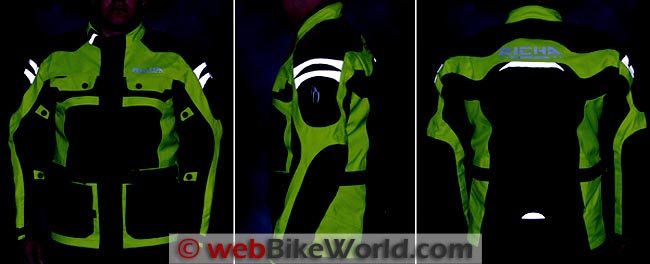
Schoeller Reflex
Yet another Schoeller technology, Reflex is a special retro-reflective material incorporated into the Rich Spirit jacket and pants. Reflex is a “special reflective thread combined with a complex weave that provides extensive protection in poor visibility conditions”, as you can see in the photo above.
“When light shines onto this fabric millions of tiny glass beads reflect the light back (retro reflection)”, according to the company.
The “bluesign” Initiative
Besides all the high-tech goodies, the textiles produced for the Richa Spirit outfit meet the worldwide “bluesign” [sic] textile standard. The Bluesign initiative is a worldwide movement to promote resource productivity, consumer safety, responsible air and water emissions and worker health and safety throughout the entire textile supply chain.
The entire supply chain and all of the raw materials, chemical components and water and energy resources for all off the materials and components used in the gear undergo an assessment, based on the Bluesign standard, to determine their “toxicological and ecological properties and risks” and eliminate harmful substances before they enter the production processes.
To meet the bluesign standard, the manufacturing plans and processes undergo an audit to evaluate conformance. All manufacturers of the supply chain who follow the bluesign standard guarantee that they are taking effective and proactive actions to be environmentally sensitive.
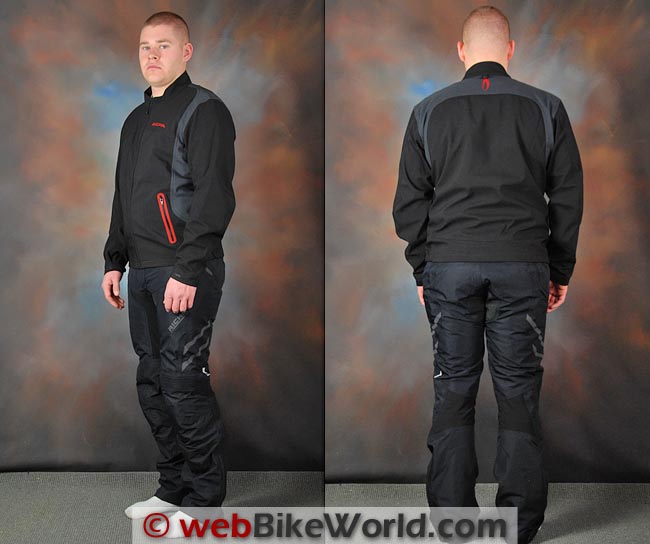
Richa Spirit Jacket Liner
Before I describe the details and on-road impressions of the Richa Spirit outfit, I’d like to describe yet another interesting feature: the liner.
The Spirit jacket includes a stylish zip-in soft-shell jacket liner that can be worn independently as casual street gear. The liner in the pants is not designed for external wear, but the jacket liner could be worn at just about any casual clothing venue without worrying about looking “bike-ish”.
The external fabric used for the soft-shell jacket liner is indeed a very nice type of mildly water-repellent outer textile that looks and feels very similar to casual jackets that would probably sell for $75 to $100.00. A touch of red trim for highlights adds some contrast and the pockets use “Dulon” brand sealed-seam zippers (YKK zippers are used elsewhere on the clothing).
The jacket liner also has its own permanently attached mesh inner lining that matches the lining of the outer shell. The hand pockets on the liner are also very comfortably lined with a high-quality micro-fleece type lining.
The liner zips into the shell with an unbranded zipper that has hefty sized nylon teeth. The zipper pull flips over 180 degrees so that it works when the liner is used as a street jacket. The liner zips up the right side of the jacket and separately on the left, where the zipper is very cleverly and very well hidden underneath a section of fabric trim.
Jacket Liner Pockets, Zippers and Liner Removal
The only fly in the ointment is that the neck and sleeves of the liner do not zip into the outer shell; they instead use the more common loop/snap system.
A single loop is sewn on to the shell at the neck and two loops on each sleeve cuff connect to snaps sewn on to tabs inside the sleeves. It works, but these fabric loops have a tendency to break, probably because the ratio of surface area to stitches doesn’t make the attachment strong enough.
The loop system makes it slightly more difficult to attach the liner (removal is easy) in this case, because it involves fishing around up and inside the Spirit jacket sleeve cuffs to find the snaps and thread them through the loops sewn on to the liner sleeve cuff. Richa made the loops are very narrow; they’re just barely larger than the width of the tab holding the straps, and this makes the sleeve installation procedure more difficult than it should be.
It probably would have been better (albeit much more expensive) to use a full surround zipper at the sleeve cuffs. Alternatively, I’d suggest Richa make the loops larger by about 3-4 mm, which would make it easier to slip the tab through. The neck actually doesn’t really need a snap, but it’s a “snap” to attach it, so it’s no bother either way.
It’s interesting to note that the sleeve cuffs on the liner have a constructed dart that allows diameter adjustment. The vertical darts use a hook-and-loop catch tab for security. However, the shell sleeve cuffs (and the Spirit pant leg cuffs) have a vertical zipper (with locking zipper pull) that allows the wearer to widen the cuff to insert an arm or leg, but once the zippers are closed, basically no other sleeve cuff (or leg cuff) diameter adjustment is possible.
This makes it a bit difficult for some gloves to fit over the sleeve cuff, at least in winter when the liner is installed, which adds to the sleeve diameter. The pant leg cuffs do fit over a pair of long touring boots, but can’t be cinched down tight, although fortunately — and at least for my size — the pant legs are snug enough that it works.
I’d suggest that Richa develop an external sleeve cuff and pant leg cuff adjustment system to the Spirit outfit.
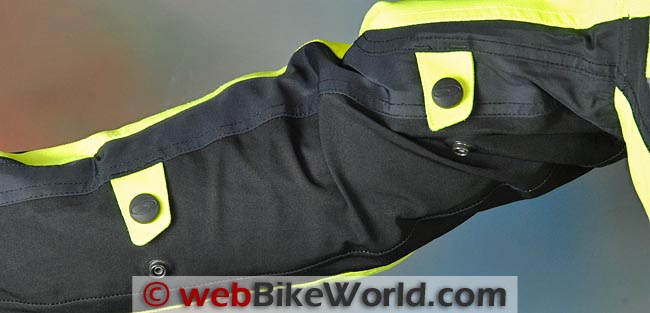
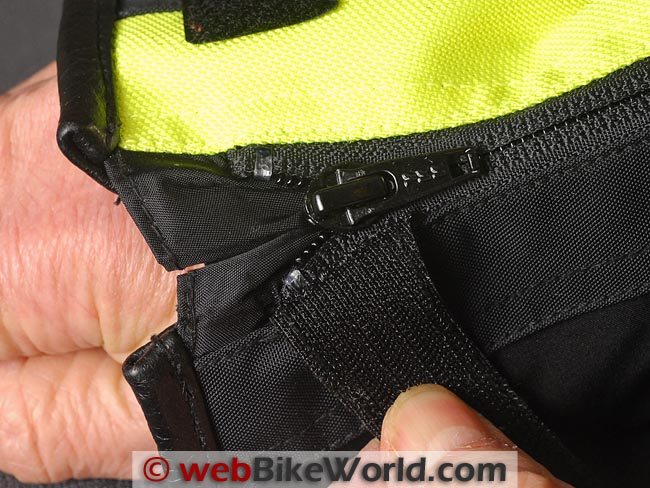
Richa Spirit Jacket Sizing
I originally ordered a Spirit jacket in size XL to try for sizing purposes. Sizing information for the Spirit outfit isn’t easy to find, probably because the gear is so new that there isn’t a lot of owner data and feedback yet.
Richa recommended a size XL, based on my measurements, but the XL fit like…an XL, and I usually take a size large. I exchanged the XL for a size large and after trying both, I can say with some confidence that they are sized as expected. The XL should fit a size 45-46 U.S. men’s jacket size and the large fits a men’s jacket size 43-44.
Note that the liner adds about 1/2 to 1 size, so you must buy the Spirit jacket and pants to fit snugly with the liners inserted in order to assure a secure fit in summer with the liners removed.
The Spirit jacket is being made in a huge size range, from size S all the way up to 8XL. That’s XXXXXXXXL! I have never seen an 8XL jacket, but I’ll be sure to call anyone wearing it “Sir”. The jacket is available in all black, silver/light gray with black trim or the black with high-visibility yellow shown in our photos.
Back to the sizing though… I can’t tell you how many motorcycle riders I see wearing clothing that is at least one or two sizes too big. It makes no sense wearing protective safety gear that isn’t fitted correctly. Remember: motorcycle clothing should be close-fitting, it is not baggy street wear!
Another reason to buy the correct size is that the snug fit helps to keep out drafty cold air. The size large Richa Spirit jacket feels very “Rev’it” snug (bordering on “tight”) when I zipper myself in.
But all I need to wear underneath in the coldest weather I ride in is a thin thermal turtleneck and perhaps a thin pair of thermal performance long underpants, like the Sub Zero underwear (review) or Spark underwear (review) brands that we reviewed.
There’s really no need to layer on sweaters and other clothing that will bulk you up — not when you have the excellent wind-blocking and “bionic climate membrane” of the Richa/Schoeller C-Change technology.
Safety, Armor and Protection
Richa includes excellent CE-approved Level 2 armor in the Spirit jacket — including a built-in (removable) CE Level 2 back protector! This is excellent news and, frankly, is a bit of a poke in the eye to one of it’s competitors, the top-of-the-line Rev’it Everest GTX jacket, which costs more at $979.99 and does not include a back protector.
I don’t see a brand name on the elbow or shoulder armor or the back protector in the Richa Spirit jacket, but the removable armor feels rugged and it sits in pockets behind the inner lining. The elbow and shoulder armor has a soft inner cup and hard outer surface, while the back protector is a thick pad with a series of blocks to give it some flexibility.
The armor feels comfortable — as far as armor does — and having a built-in back protector is a definite bonus. It is barely noticeable (in fact, I didn’t realize it was there until I deconstructed the jacket for the review), unlike accessory back protectors, that usually add various levels of “uncomfortableness” to street gear.
Jacket Construction and Materials
The outer shell of the Richa Spirit jacket is made mostly from the NanoSphere treated Schoeller Dynatec fabric. This is sort of a heavy-duty Cordura competitor and it gives the shell a sturdy composure and it has a slightly stiff “hand”, or feel.
Put on the Spirit jacket and the combination of the Dynatec outer shell and the inner armor gives one about the most protective cocoon-like feeling you’ll find in textile motorcycle gear. Also, the jacket has a short zipper that attaches to the Richa Spirit pants for more security.
The stitching and construction are excellent, with straight lines and no hanging threads. Just about any wear point on the pockets or seams throughout the jacket have extra sections of bar-tacked stitching for added strength — the sign that extra care has been taken to ensure strength and integrity.
The jacket has a nice, wide adjustment belt at the waist and rubberized button covers. A full-length strip of hook-and-loop secures the front with a double-folded seal along the placket. The neck has a basic hook-and-loop tab that seems a bit out of place on this jacket. It needs more adjustment options and perhaps some type of movable snap, like the system used on the Rev’it jackets. The neck lining in the shell has an exceptionally thick and padded fleece lining.
Waterproof Outer Shell
The NanoSphere process, combined with the bonded C-Change membrane on the inside, makes the Spirit jacket waterproof at the outermost boundary layer. There is no separate waterproof liner in the Richa Spirit jacket because the shell itself does the job.
This is the “Holy Grail” for many motorcyclists who have written us many times over the years, requesting a jacket that is waterproof without requiring a separate liner. But, like in the Rev’it Everest GTX gear, it’s not going to come cheap, unfortunately. Such is life…
Pockets and Storage
While we’re on the subject of the outer shell, the Spirit jacket has two large patch pockets located at the lower front. These are external “cargo” pockets that measure about 17 cm deep and 21 cm wide (~6-3/4″ by 8″). Sewing the pockets completely to the outside of the Dynatec shell maintains the safety and waterproof integrity of the shell.
The construction gives the pockets a limited carrying capacity though, because the expansion panels are external and you wouldn’t want 15 cm of fabric hanging out front. The pockets fit a set of keys, cell phone or ear plugs, but not a pair of gloves.
The jacket also has a chest pocket on either side and these are extra deep, at about 17 cm and about 14 cm wide. They are also waterproof but the pocket sleeve on these lies behind the Dynatec liner.
All of the pockets have a fold-over lip and heavy-duty rubber-covered metal snap, along with a strong strip of hook-and-loop for closure. The hook-and-loop ends before the outer edge of each pocket flap, where a rubberized grab tab is located for convenience. The hook-and-loop is so strong — at least when the jacket is new — that opening the pocket is a nearly two-handed affair.
The jacket has a deep inner pocket secured by a zipper just inside the left placket — perfect for a wallet. The inner left pocket of the liner fits a cell phone and the right-hand side has another pocket. The jacket shell includes an internal pocket on the left-hand side only.
Ventilation and Other Details
You may not have noticed it by looking at the photos of the Rich Spirit jacket, but it has no vents. The Schoeller C-Change climate-adaptive membrane is designed to replace the traditional venting system found on motorcycle jackets.
The idea is that the vents could actually defeat the functionality of the C-Change membrane when the incoming air bypasses the system. Of course, no vents means waterproof integrity is assured; vent openings are the bane of the jacket designers’ existence, because any opening in the shell means a usually complex system to prevent water ingress when the vent is closed.
Since we’re now deep into winter, a warm-and-humid Mid-Atlantic weather evaluation of the C-Change system will have to wait. But in the meantime, we tried various high-temperature scenarios indoors to test the concept.
Warm Weather Simulation
Our trials got off to a good start by wearing the jacket and pants (with liner) under the hot lights of the photo studio. The proximity of the lights usually gets the subject sweating in no time at all — you may have noticed the florid and sweaty faces of the models in some of the webBikeWorld reviews before.
But it was indeed noticed right away that the Spirit jacket and pants indeed seemed much “cooler” in this situation and there no buildup of moisture on the inside.
Next, we tried wearing the outfit indoors, outdoors and inside a store in an attempt to simulate summer weather. We came away impressed also by those admittedly simple evaluations. The C-Change membrane does seem to meet Schoeller’s claims, somehow moderating the temperatures and doing a very good job at transferring the moisture. In other words, it just doesn’t feel as hot and sweaty underneath as it should.
Another benefit of the C-Change membrane is less bulk in the jacket and pants. There is no need for an additional water/windproof layer and that gives the clothes a better fit. This is most noticeable when wearing the outfit with the thermal liners removed.
Cold Weather Trials
This holds for cold-weather riding, of which we have had plenty. I guess it depends on your definition of “cold”, but the outfit has been worn while riding for extended periods of time, in temperatures ranging from 34 degrees F (1 C) up to 44 degrees F (7 C) maximum.
Normally, in this type of weather, I would wear some type of long thermal underwear underneath the riding outfit and possibly a windproof vest over a turtleneck. But I found that with the c_change system, I can get the same level of comfort without the thermals.
I also tried a back-to-back comparison with an Akito Desert jacket and pants we’re also in the process of reviewing. With that outfit (the liners were installed in the Richa and Akito gear) I could definitely notice a difference. I had to wear the set of thermals to get the same comfort with the Akito outfit.
After these admittedly subjective and very un-scientific tests, I’d say that it seems that the C-Change membrane makes a noticeable different in keeping the rider cooler than expected in warm temperatures and slightly warmer than expected in cold temperatures.
So the technology appears to be promising, but it will probably take a few months of riding in real-world temperature and climate conditions to fully evaluate the gear.
What I can say is that it does have good promise for warmer weather and the fact that it is also fully waterproof (and windproof), and that’s a plus. In the meantime, I am interested in hearing from other Richa Spirit owners on their experiences.
| The wBW Opinionator: Richa Spirit C-Change Jacket | |
|---|---|
| Picks… | …and Pans. |
|
|
Conclusion
First of all, kudos to Vega Helmets for importing and distributing Richa gear in the U.S.A. The Richa Spirit jacket and pants are the initial offering and more Richa gear will follow.
Since the Spirit outfit is the top-of-the-line Richa product that also incorporates the most technology, it is also the most expensive. Richa does make a nice selection of very reasonably priced motorcycle gear, so there’s lots more to come.
The Richa Spirit jacket is a different take on the classic textile 3/4-length motorcycle jacket. The various Schoeller technologies that have been incorporated, along with the CE-approved armor and included back protector — and the very nice street-ready liner — make this a hard-wearing, protective outfit that honestly feels like it will outlast a couple of lesser outfits.
The price may seem a bit steep, but when you start to compare the features and what is included in the price to jackets at both higher and lower price points, serious riders will realize there’s actually a lot of value for the money.
Part II: Richa Spirit Pants Review | Also: Richa Arctic Gloves Review
|
wBW Product Review: Richa Spirit C-Change Jacket
|
|
|---|---|
| Manufacturer: Richa NV (Belgium) | List Price: $699.99 (larger sizes +$60.00). |
| Colors: High-visibility yellow. Silver/gray. Black/black. | Made In: Unknown |
| Sizes: S to 8XL. | Star Rating (1-5): |
| Review Date: January 2012 | |
|
Note: Item was provided by a retailer, distributor or manufacturer with these Terms and Conditions.
|
|
Owner Comments and Feedback
See details on submitting comments.
From “K.K.” (October 2012): “I purchased the Richa Spirit jacket and pants in August. While the jacket and pants have some fine features, great styling, excellent materials, and are very well made, there are some major drawbacks as well.
Firstly, the neck is cut much too low, leaving my neck exposed to the cold. It forces me to wear a high neck softshell or turtleneck sweater under it to make it comfortable. I have not been caught in the rain with it yet, but I can only think that the softshell or turtleneck will act as a wick and cause moisture to get into the jacket. The softshell that comes with the jacket is also cut too low on the neck.
Secondly, as the reviewer noted, some vents would really extend the comfort range of the jacket. When I purchased this jacket, it was over 100 degrees and very dry, and indeed the jacket and pants were very comfortable. However, throw in some humidity, and the jacket becomes a sauna.
I would suggest some (arm) pit zips (waterproof, of course) and an exhaust vent under a flap at the upper back, to get some air moving through it during high heat/humidity conditions. Given the low neck and the lack of vents, this gear has a relatively narrow temperature range when it is comfortable, just the opposite of what I expected.
I also find the two upper chest pockets to be a bit of a pain to use. One has to reach into them from the top, and given their position, you end up looking like Big Bird with your elbows way up in the air. These pockets would be much more useful with vertical waterproof zippers.
Also, both internal pockets are on the same side, causing the jacket to be bulkier and heavier on the left side. The cell phone pocket should be moved to the right.
The only flaw with the pants is the lack of an expansion dart at the waist. I’m a pretty skinny guy but even I have a bit of trouble wiggling into them. I can only imagine someone of more substantial girth really having trouble getting them on.
Having said all that, the Spirit jacket and pants make me feel the safest I’ve ever felt on a bike. Great fit (excepting the neck), great protection, and great features. If I ever have a get off, I expect these to stand up better than anything else I have worn or even tried on. If Richa addresses my issues, I would not hesitate to buy them again.”
From “S.K.” (February 2012): “I own a BMW Comfortshell which uses the same C-Change technology, and I have to say it works great when it works-it keeps water out, breaths when it is warm, and seals when it is cold.
Unfortunately, the membrane itself is not so durable as I have found out. After about two years of service, I had sprung leaks in the elbows. No big deal, you can patch these things, right? I turned the jacket inside out, prepped the worn area with some rubbing alcohol, and applied some McNett Seam Grip (which uses toluene as a solvent).
To my horror, I could visibly see the membrane breaking down. Just to be sure, I contacted Schoeller about this, and they confirmed that it is not resistant to certain solvents as it is a Polyurethane based membrane unlike Gore-Tex, which is PTFE based.
The obvious lesson is to never bring these solvents into contact with your very expensive jacket. Unfortunately, some of these solvents, such as toluene, are present in the gasoline you so often handle. So don’t spill any gas on your jacket either.”
Editor’s Note: I’m investigating this issue with Richa and Vega Helmets and will report back. Note that the BMW warranty is 1 year, while the Richa warranty is 2 years and Vega said they will support the product here in the U.S. on the same basis.
From “W.K.” (January 2012): “It was nice to read your review about the Richa Spirit Jacket. I’ve been using it for over a year now here in The Netherlands and it proves to be a fine jacket.
I do have some remarks though: I also have problems with the zippers on the sleeves. The weatherproof liner tends to get stuck there very easy. The Reflex material on the shoulders gets cracked and half loose.
The big pockets on the hips are definitely waterproof meaning that water that comes in (it does a lot in heavy rain!!!) never comes out by itself anymore. After heavy rain those two pockets will be filed halfway with water what won’t come out by itself. I’ve sent the jacket back to report this but Richa didn’t do anything about it.
The shop where I bought the jacket tried to fix it by making an extra layer of Velcro in the pocket but that didn’t do the trick. So you all be warned not to put anything of value in those hip pockets!
Further on the jacket is weatherproof and nice.”


